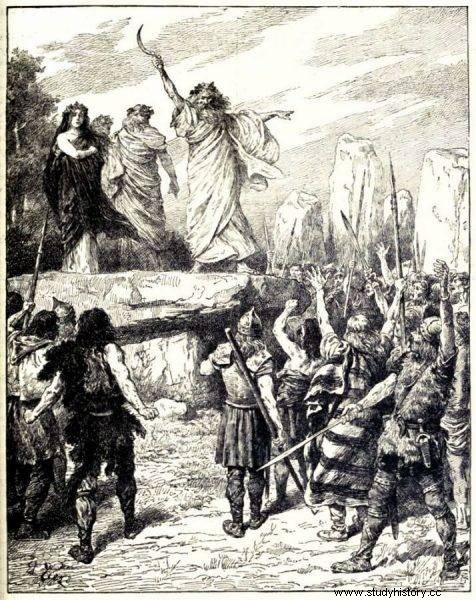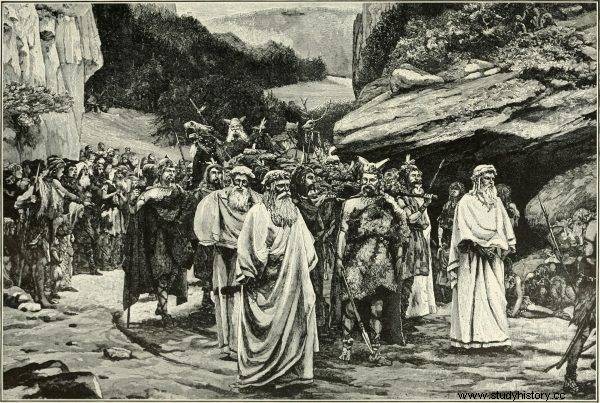In the south of Poland, traces of a Celtic settlement from before 2.5 thousand were discovered years. The Celts who got here brought knowledge and skills unknown to the locals.
The cradle of the Celts is the area of the Lower Rhine and Danube, north of the Alps. It was in this area of Europe (in the mountainous areas of Champagne, Burgundy, Rhineland, Württemberg, Bavaria, Switzerland, Austria and the Czech Republic) that a civilizational leap took place, which gave the Pracelts priority and advantage over other peoples. Around 800 B.C.E. discovered the treatment of iron, which began to replace the previously used bronze. From the middle of the first millennium BC, the Celts began to expand in every direction. They occupied all of today's France, which was called Gaul in Roman times after the Celts (Galatians, Gauls). They reached the Iberian Peninsula. They also set out for the British Isles, settling in Britain and Ireland.
The second direction of Celtic migration was the east and south of Europe. Around the 5th century BC they settled in the region of Bohemia and Moravia, then Hungary and Slovakia. They probably reached today's Silesia and Lesser Poland from the south.
Militant Celts
The Celts were famous for their bravery and predatory raids. More than once they harassed the Roman Republic and Greece . In 390 BC plundered Rome, invaded Macedonia and Greece in 279 . They had no qualms about robbing and desecrating the famous temple at Delphi. In the early days of their expansion, Celtic warriors had a technological advantage over other tribes. They used iron, double-edged swords. They also used spears, round wooden shields with iron, and two-wheeled chariots. They were masters of traveling great distances and the use of wheeled transport . They migrated in large groups, with children and women. At the end of the 2nd century BC they invented a single spur. They are also credited with the proliferation of horse shoeing and the use of a saddle.

The Celts were famous for their bravery and predatory raids.
The heroic feats of Celtic warriors were sung by bards in their songs. They belonged to the priestly caste. Their task was to preserve the collective memory in the form of stories, vocal pieces, etc. Among the priests there were also prophets who gathered knowledge about nature and prepared sacrificial rites. At the top of the hierarchy were druids who knew the movements of the stars, guarded the moral law and judged in disputes between the members of the tribe. Celtic culture developed its own calendar based on the phases of the moon. Later in the British Isles they used their own writing - the so-called ogamic (from the Celtic god of knowledge Ogma).
Though the Celts plundered, burned and murdered, their expansion did not have to be marked by violence. They were also able to integrate with local peoples. It was like that on the Iberian Peninsula, where, after assimilation with the local Iberians, they created a new ethnic group - Celtybers. They got the best from others. For example, they took a potter's wheel from the Greeks. From the end of the 3rd century BC they also minted their own coins, modeled on Macedonian starters.
The Celts and the Polish cause
The Celts came to our lands at the turn of the 5th and 4th centuries BCE. They came from the area of the Middle Danube - Moravia and Lower Austria. Their expansion was considered to be peaceful . There are no traces of fights with local peoples. Besides, scientists believe that such fights were not needed at all, because the regions of Silesia and Lesser Poland, where the newcomers settled, were very sparsely populated. The Celts settled in four major enclaves.
The first one was located in Lower Silesia, in the area of today's Wrocław. The traces of their presence are very clear. Scientists have discovered skeletal burials with distinctive furnishings. Weapons were hidden in men's graves - incl. sword, spearheads and shield. In turn, ornaments were discovered in women's burials - bronze and iron clasps or bracelets. The traces of the Celts in Lower Silesia are also present on Góra Ślęża, which played a cult role. The presence of Celtic priests and the celebration of rituals there is evidenced by the stone carvings that have survived to this day.

The Celts came to our lands at the turn of the 5th and 4th centuries BCE. They came from the Middle Danube area
The second group of Celts came to the Opole region and Silesia - in the region of the Głubczycki Plateau and Racibórz. Near Opole, researchers discovered the remains of a settlement that consisted of several dozen pole houses . Also found were a pottery kiln, ornaments, gold coins, glass beads, sapropelite bracelets and fragments of ceramics typical of the Celts - made of clay with an admixture of graphite.
Perhaps the desire to exploit salt deposits pushed the Celts to settle in the Wieliczka region in Małopolska. They probably came to this area around 270-170 BC. Many traces of their presence remained between Jura Krakowsko-Częstochowska and the valleys of the Nida and Dunajec. Celtic groups also reached the east of Małopolska and the region of Podkarpacie. However, this direction of migration is the least understood.
Innovators from millennia
Scientists emphasize that the Celts did not settle in today's Poland by accident. They were probably guided by, among others soil quality. They chose places with fertile loess soils for their settlements. Their arrival marked a real technological leap. The Celts had skills and equipment unknown to the local peoples. They used iron tools - scissors, blacksmith tongs, hammers, axes, files. Many of these tools were used almost unchanged until the 19th century. The Celts also used a potter's wheel, unknown in these lands. And they were masters of iron processing.
What happened to the "Polish" Celts? Some assimilated with the locals. This is what happened, among others in Małopolska, where the Celts integrated with the representatives of the so-called Przeworsk culture , identified with the Germanic tribe of Vandals. The remaining groups, which were not absorbed by the local tribes, probably migrated to other parts of the world, also due to the migration of Germanic peoples to our lands. The Celts were accustomed and eager to wander. If they could find another place to live, they didn't hesitate. Today, Celtic remains in Poland are another testimony to the cultural and ethnic richness of our country's prehistory.
Bibliography:
- Kaczanowski P., Kozłowski J.K., The earliest history of the Polish lands (up to the 7th century) , Krakow:Fogra, 1998
- Kokowski, Ancient Poland , Warsaw 2005
- Friedrich Schlette, Celts , Łódź Publishing House, 1987
